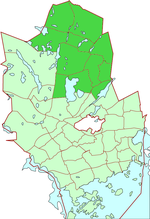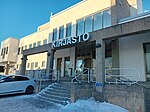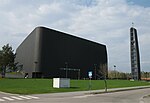Hotel Korpilampi
Buildings and structures in EspooHotels in Finland

Hotel Korpilampi is a hotel in Lahnus, Espoo, Finland, operated by Pandox. Construction of this first so-called "wilderness hotel" in the Helsinki capital region started in 1975 and the hotel was opened in 1977. The hotel became publicly known in connection with the Korpilampi seminar in 1977. The hotel has a total of 156 rooms and 17 conference halls. The hotel also has a restaurant, a spa and a health club. Lomaliitto, the previous owner of Hotel Korpilampi, went bankrupt in 2009. After the bankruptcy the hotel was closed for a year and a half until Pandox bought the hotel.
Excerpt from the Wikipedia article Hotel Korpilampi (License: CC BY-SA 3.0, Authors, Images).Hotel Korpilampi
Korpilammentie, Espoo Lahnus (Pohjois-Espoo)
Geographical coordinates (GPS) Address Nearby Places Show on map
Geographical coordinates (GPS)
| Latitude | Longitude |
|---|---|
| N 60.325277777778 ° | E 24.729722222222 ° |
Address
Hotelli Korpilampi
Korpilammentie 5
02970 Espoo, Lahnus (Pohjois-Espoo)
Finland
Open on Google Maps











